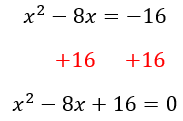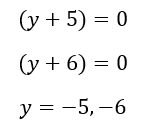The SAT Math section is notoriously algebra-heavy, and many of the more frequently tested algebra questions involve quadratics. Some students struggle with quadratic questions because they see them and immediately make things way too complicated. In reality, most SAT quadratic questions are designed to be solved in just a few simple steps.
Step One: Simplify the Quadratic
Quadratic questions are easy to spot because the variable will always be squared.
![]()
The above example would be ideal because there is no coefficient in front of the squared variable and all of the numbers are on one side of the equals sign. However, SAT quadratic questions aren’t usually presented in such a straightforward way.
First, the squared variable might not be by itself. Instead, it might have a coefficient attached to it. In these cases, it’s best to divide the equation by any common factors.

Second, the equation may not equal zero at first. Make one side of the equation equal to zero as early in the solving process as possible.

Step Two: Orient Yourself
When it comes to quadratics, there are really only two directions you can travel. Either the question will provide you with an expanded equation that you need to factor or the question will provide you with factors that you need to expand. Identifying which direction to travel is half the battle.

You should factor if a quadratic question gives you an equation and asks you to find any of the following:
- Solutions
- Roots
- Sum/difference/product/quotient of the solutions or roots
- Maximum or minimum
You should expand if the question gives you the solutions or roots and asks you to find one of these:
- An equation
- The value of a coefficient inside an equation
Step Three: Look for Shortcuts
One way to save some time on quadratic questions is by looking out for perfect squares. On the SAT Math section (no calculator) in particular, many of the quadratic questions feature perfect square trinomials that follow very predictable patterns.

Take the following equation, for example.
![]()
The above equation includes perfect squares in the first and third terms.

We can therefore easily factor this equation.
![]()
Even when the given equation is not a perfect square, we can still use shortcuts to solve.
![]()
Instead of reaching for a long and complicated formula to factor this equation, let’s simply ask ourselves, “What factors of -60 add up to 11?” The answer is 15 and -4, so we can factor the equation as follows:
![]()
A final shortcut to keep in mind pertains to the roots themselves. Some SAT word problems describe a quadratic with only one solution. In these cases, use the solution to create two matching binomials and expand from there.

Step Four: Answer Their Question, Not Yours
Once you’ve taken the above steps, you’re ready to solve. Just be careful to answer exactly what is asked of you. The SAT is adept at creating answer choices that solve a portion of the equation but do not answer the question itself.
Let’s try using our step-by-step approach to solve a typical SAT quadratic question.

First, let’s simplify the equation by setting the equation equal to zero.
![]()
Second, we need to decide which direction to take our math. Will we factor or expand? I see the key word “solutions”, so it looks like I’ll need to factor.
Third, let’s check to see if we can take any shortcuts. I don’t see any perfect squares, but I do know that only two factors of 30 add up to 11: five and six. I can therefore factor as follows:
![]()
Aha! Answer D shows the number 6. But wait! The question asked about the difference of the solutions. We must set each binomial equal to zero to solve for the solutions.

Answer B shows one of these solutions. However, recall that the question asked for the difference of the two solutions, not the solutions themselves. Therefore, the correct answer is C.
As you can see, quadratic questions are more bark than bite. With careful attention to the wording of the question and practice with the various question types, these questions can become some of the easiest math questions to solve on test day.

